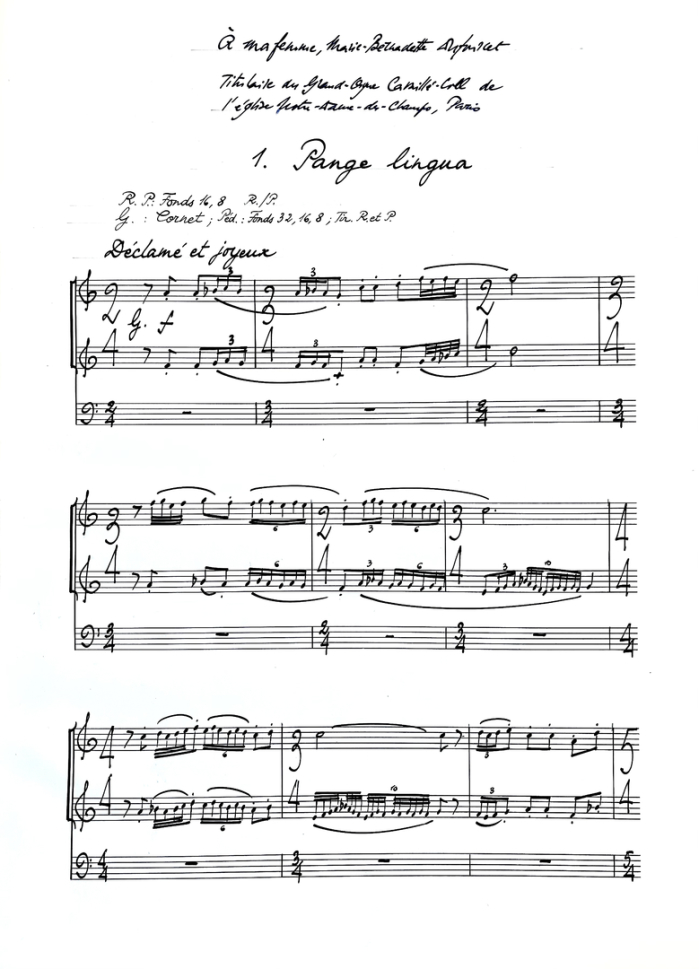
Pange lingua
Title, Duration, Place, Year, Publisher, Dedicated to, Premiere (performer(s), place, date)
PANGE LINGUA, 10', Bayonne, 1996, Leduc, à ma femme Marie-Bernadette Dufourcet, Naji Hakim, Liebfrauenmünster, Ingolstadt, Germany, 01.09.96
Cette pièce pour orgue est bâtie sur l'hymne au Très Saint-Sacrement, « Pange lingua» (texte de Saint Thomas d'Aquin). Elle s'articule en six variations distinctes, inspirées de la structure du poème. La première, « Pange lingua », est une variation ornementale sur un duo de cornet. La deuxième, « Nobis datus », se présente comme une brève toccata sur le tutti. La troisième, « In supremæ nocte cœnæ », est une lente méditation dans un style de choral, sur les jeux de bourdons et gambes. La quatrième, « Verbum caro », juxtapose trois motifs en alternance avec les différentes périodes du plain-chant. La cinquième, « Tantum ergo », déclame le thème en octaves à la pédale, accompagné d'harmonies saccadées dans un rythme trochaïque à la française. Le mouvement final, « Genitori, genitoque », est une danse brillante de structure rhapsodique.
This piece is based on the hymn to the Holy Sacrement, “Pange lingua” (text by Saint Thomas Aquinas). The piece consists of a set of six variations inspired by the structure of the poem. The first, “Pange lingua”, is an ornamented duo on the cornet. The second, “Nobis datus”, is a short toccata on the tutti. The third, “In supremæ nocte cœnæ”, is a slow meditation in a choral style on the bourdons and gambas. The fourth, “Verbum caro”, uses three motives alternating with the different periods of the plain song. The fifth, “Tantum ergo”, declaims the theme in octaves on the pedal, with a chordal accompaniment in trochaic rhythm, à la française. The final movement, “Genitori, genitoque”, is a brillant dance in rhapsodic style.
Dieses werk basiert auf einer Hymne des heiligen Abendmahls, „Pange lingua“ (Text von Thomas von Aquin). Dem Stück liegt eine sechsteilige Variationsfolge zugrunde, die von der Struktur des Textes angeregt wurde. Die erste Variation, „Pange lingua“, besteht aus einem verzierten Duo im Kornett. Die zweite, „Nobis datus“, ist eine kurze Toccata im Tutti, die dritte, „In supremæ nocte cœnæ“, eine langsame Meditation im Choralstil mit Bordun- und Gambenregister. Die vierte Variation, „Verbum caro“, verarbeitet drei Motive abwechselnd mit den verschiedenen Perioden des cantus planus. Die fünfte, „Tantum ergo“, führt das Thema in Oktaven im Pedal mit staccatoartiger akkordischer Begleitung in trochäischem Rhythmus, nach französischer Manier. Der Finalsatz, „Genitori, genitoque“, ist als brillanter Tanz in rhapsodischem Stil gestaltet.
Esta pieza para órgano está construida sobre el himno al Santísimo Sacramento, “Pange lingua”(texto de Santo Tomas de Aquino). Se articula en seis variaciones distintas, que se inspiran en la misma estructura del texto. La primera, “Pange lingua”, es una variación ornamental sobre un duo de cornetas. La segunda, “Nobis datus”, se presenta en forma de tocata breve sobre el “tutti”. La tercera, “In supremæ nocte cœnæ”, es una lenta meditación en estilo de coral, sobre juegos de tapadillos y gambas. La cuarta, “Verbum caro”, yuxtapone tres motivos que alternan con los diferentes períodos de canto llano. La quinta, “Tantum ergo”, declama el tema en octavas en el pedal, acompañado de armonías entrecortadas en un ritmo trocaico a la francesa. El movimiento final, “Genitori, genitoque”, es una danza brillante de estructura rapsódica.

